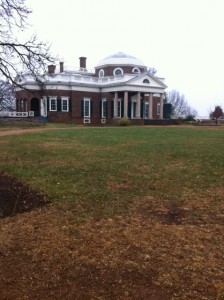I spent last week in Charlottesville, Virginia, visiting family over Thanksgiving, and found it to be a very livable — and visit-able — city, which I highly recommend for baby boomer travelers.
Mostly I knew it as the home of the University of Virginia and Monticello, the home of Thomas Jefferson, both of which were designed by our third president. Those two sites alone would warrant a visit, but anyone interested in history, outdoor activities and good food would find a welcome respite in Charlottesville.
Now here are ten things I didn’t know about Charlottesville:
* Some of the most coveted and prestigious student residences at the University of Virginia have no bathrooms. These are historic ground-floor single rooms facing the Lawn, the long expanse of greenery that extends from below the famous Rotunda that marks the central focal point of the university Grounds (campus). The rooms, situated along colonnaded walkways designed by Thomas Jefferson, are reserved for exceptional students in their senior year, and they have to apply to get in (there’s a long waiting list). Bathrooms and showers are located in outer buildings behind the east and west corridors, and residents can sometimes be spotted making a dash to them in their bathrobes late at night. Nor do the rooms have air conditioning or kitchens, but they do have wood-burning fireplaces, brass name tags on the doors, parking spaces and nearby gardens.
* Both Jefferson’s stately Monticello and the redbrick-and-white-columned University of Virginia are United Nations World Heritage sites; Monticello is the only house in the U.S. on that list, with the exception of Taos pueblos.
* Monticello’s entry hall displays a pair of elk antlers that are the only remaining artifact from the Lewis and Clark expedition of 1804-06 (commissioned by Jefferson following the Louisiana Purchase) that explored the western part of what would eventually become the continental United States. Monticello also showcases Jefferson’s ground-breaking architecture and ingenious inventions.
* Along with Jefferson, the third U.S. president, the fourth and fifth presidents also lived in Charlottesville and environs. You can tour the homes of James Madison — Montpelier, located about 20 miles north of the city — and James Monroe, whose estate is called Ash Lawn-Highland, which is less than three miles from Monticello (which in turn is just a short drive southeast of Charlottesville). All three lived on spacious estates and, paradoxically, all three were slave owners despite their theoretical adherence to freedom and the rights of man. The organizations now running the estates don’t try to sugarcoat this paradox, and their presentations prominently feature the hardships of the enslaved members of the household.
* At Montpelier, you can stand in the upstairs room (dubbed the Old Library) where Madison conceived the outlines for the United States Constitution. The restoration of Montpelier, which was owned by the DuPont family and extensively enlarged by them in the 20th century, is ongoing and involved tearing down the modern elements and returning the house to its original size as occupied by Madison. The restored house reopened in 2008 and the Old Library is scheduled to be furnished in period style by February 2014.
* A longtime Charlottesville institution, appropriately called Spudnuts, specializes in donuts using potato starch rather than wheat flour. Spudnuts was once a big national chain with hundreds of outlets but went out of business, and today only about 35 independently owned branches survive in nine states.
* The town of Gordonsville, not far from James Madison’s Montpelier, is home to a terrific down-home barbecue joint (called The Barbecue Exchange) that features picnic tables, paper towels for napkins and cafeteria-line ordering, so you might be surprised to learn that the chef-owners, Donna and Craig Hartman, are graduates of the Culinary Institute of America in upstate New York. (Or maybe not, once you taste their barbecue.)
* The highest waterfall east of the Mississippi is located within an hour and a quarter’s drive west of Charlottesville, in the George Washington National Forest. It’s called Crabtree Falls and has a series of spectacular falls cascading down a mountainside for a thousand feet or more. Best of all, you can hike up the mountain alongside the waterfall on a series of switchbacks that are only moderately challenging (at least when some of the areas aren’t iced over as they were when we hiked it on this particularly frigid Thanksgiving). It’s extremely dangerous to try to climb some of the slippery rocks off the trail, however, so don’t even think about it.
*There are at least six entrances to the Appalachian Trail, the 2,200-mile footpath that extends from Georgia north to Maine, off Shenandoah National Park’s famous Skyline Drive, which winds along the crest of the Blue Ridge Mountains west of Charlottesville. You can park at various points and take moderate two-to-four-mile hikes along the Trail to break up your journey (the entire length of the Skyline Drive is 105 miles), or stop at some of the drive’s 75 overlooks.
* Charlottesville is home to the only museum in the United States dedicated to the exhibition and study of Australian Aboriginal art: The Kluge-Ruhe Aboriginal Art Collection of the University of Virginia. It was compiled by the late American businessman John Kluge and the late Kansas professor Edward Ruhe.
Be sure to download my free report, “How to Ride the Coming Wave of Boomers,” available here. It’s all about the best ways to market travel to baby boomers — the biggest-spending group of travelers the world has ever seen. It’s also the easiest way to subscribe to my blog, so you won’t miss a posting. Thanks!














14 Responses to Ten Things I Didn’t Know About Charlottesville, Virginia